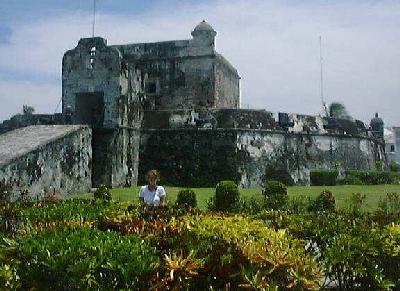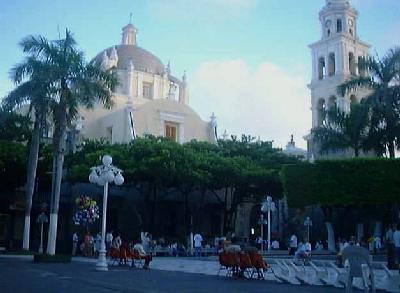
Veracruz
Tuesday August 31st - Thursday September 2nd 1999
From our base in Tula, we went to Mexico City for the day on Monday to try to find out what had happened to Veronika's application for a visa for Honduras. We had originally applied from Washington, sending our application to San Francisco, explaining that we were travelling around the US and Canada and that we would pick up the visa in SF. The man we spoke to at the Honduran consulate assured us that this would be okay. However, when we were in Vancouver, we received an email from our friends in Washington telling us that our application had been returned untouched. Robin then forwarded the application to us in Vancouver, and we re-submitted it to the consulate in San Francisco. When we were in San Francisco we visited the consulate on July 20th, and the same man told us that Veronika's application had been sent on to Honduras for approval, and that this could take up to 30 days. Eventually we agreed that he would forward the authorisation to the Honduran embassy in Mexico City for us to pick up. Finally, when we got to Mexico City, there was no authorisation waiting for us; eventually a phone call to San Francisco lead to the discovery that the man in San Francisco was now claiming that the application hadn't been sent to Honduras until August 3rd, a full two weeks after we were in San Francisco, and nearly two months after we initially sent it to him. We're now in the situation where we don't know if Veronika's application will be approved in time for our arrival at the Honduran border. If not, we might well have to try to get from El Salvador to Nicaragua direct. The moral of the story is, if you're unfortunate enough to require a visa for Honduras (with my British passport, I don't need one), then apply *way* in advance - we were told in Mexico that in some cases approval can take over three months. Some countries apparently don't want a tourist industry.
Anyway, my moan out of the way, I can get on with telling you about Veracruz. Sitting on the coast of the Gulf of Mexico, Veracruz is an interesting tropical port; there's not a great deal to see or do (other than sit around the Zocalo people-watching), but it's a pleasant enough stop on the way south. The town played an important role in Mexican history, as Cortes made his first landing on the Isla de los Sacrificios just offshore from the mainland. The island got its name from the remains of human sacrifices which Cortes found there. Cortes next anchored off San Juan de Ulua, so called because Juan de Grijalva landed there while exploring from Cuba on St John's Day 1518, and the local natives kept repeating the word "culua" (this story comes courtesy of the Veracruz tourist board, who were very friendly and helpful, although their leaflets have a curious command of English - a handout describing the beaches exhorts visitors to "Practice sports, no violence").
Veracruz was until 1760 the only port allowed to handle trade with Spain. This made it a prime target for pirates who were based on some of the islands in the Caribbean, and there were numerous attacks. In 1567 nine English ships led by John Hawkins entered the harbour with the intention of defying the Spanish trade monopoly by selling slaves. They were trapped by a Spanish fleet, and only two ships escaped, one of them carrying Francis Drake. Probably the nastiest attack was in 1683. Laurent de Gaff led 600 men into Veracruz. They locked the city's 5000 people inside the churches, killing anyone who tried to escape, got very drunk and threatened to blow up the churches unless the population told them where their valuables were hidden. Partly in response to this threat, the Spanish authorities built a series of nine forts around the city wall; the only one remaining, the Baluarte de Santiago, was built in 1526.

The Baluarte de Santiago, Veracruz
Veracruz is known in Mexico as four time heroic: the Spanish were finally kicked out in 1825; the French were repelled from the city in 1838 during the "Pastry War", so called because one of the claims for damages the French had against Mexico concerned a French pastry chef whose restaurant was trashed by Mexican soldiers; 1000 Veracruzans died in 1847 when the Americans bombarded the city for a week; and in 1914, the Americans again invaded the city to prevent a shipment of German weapons reaching Victoriano Huerta, the leader of one of the sides in the Mexican civil war raging at the time. The Mexican casualties during the last intervention alienated everyone in Mexico, even Huerta's opponents.
On a slightly cheerier note, the harbour of Veracruz was the point where the Olympic torch was brought ashore in 1968 on its way to Mexico city. a fact which is commemorated in a memorial on the waterfront. The harbour itself is not all that busy, but it is the site of a major Mexican naval base, so there are plenty of sailors strolling about in uniform. The waterfront area is also home to many souvenir stalls, mostly selling the usual crap that people think tourists want to buy.
More interesting is the Zocalo. This square has a circular stage in the middle, surrounded by palm trees, which are then surrounded in turn by bars, cafes and restaurants, the town hall and the cathedral. In the evening, people gather in the square in what seems to be typical Mexican fashion; numerous wandering musicians try to drown each other out and obtain money from visitors. Sometimes charming, this can be very annoying when you're trying to have a quiet coffee in the morning and you get a filthy look for refusing to pay for the privilege of having your peace ruined by some cheesy band. In the evening though, it is highly entertaining. If you visit Veracruz, be sure to compare the prices if you want to have a drink - we found that the cost of a beer differed by as much as half in outdoor bars right next to each other.

The Zocalo in Veracruz, with the cathedral in the background
Mexico index | Travel index | Family history | Romany | Main index